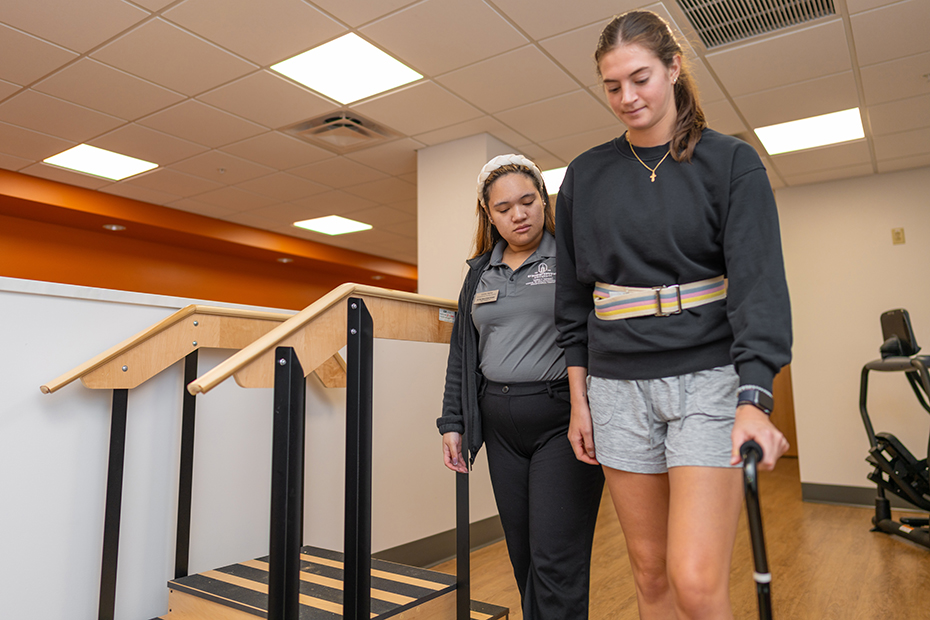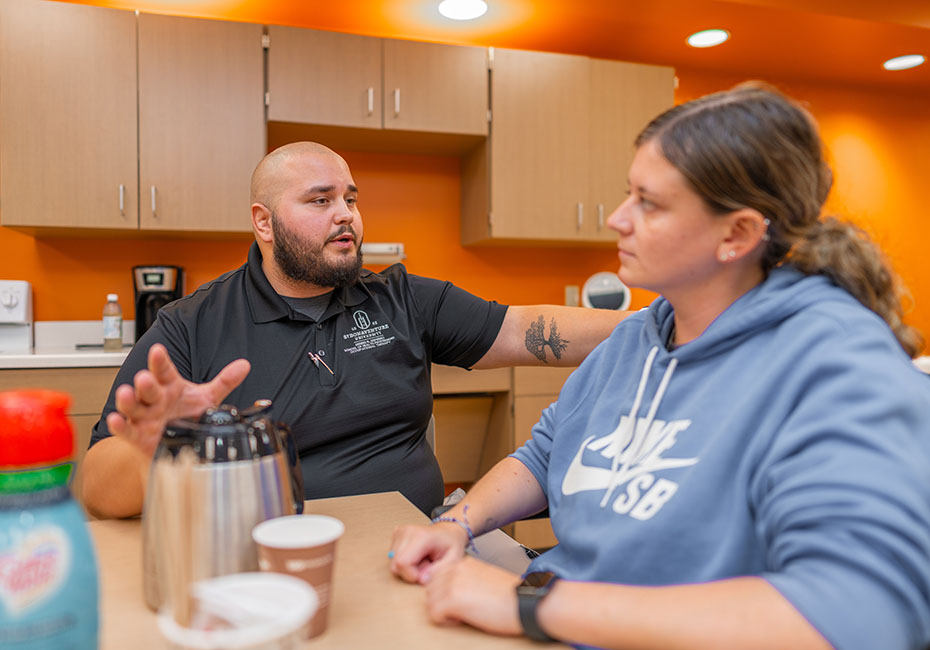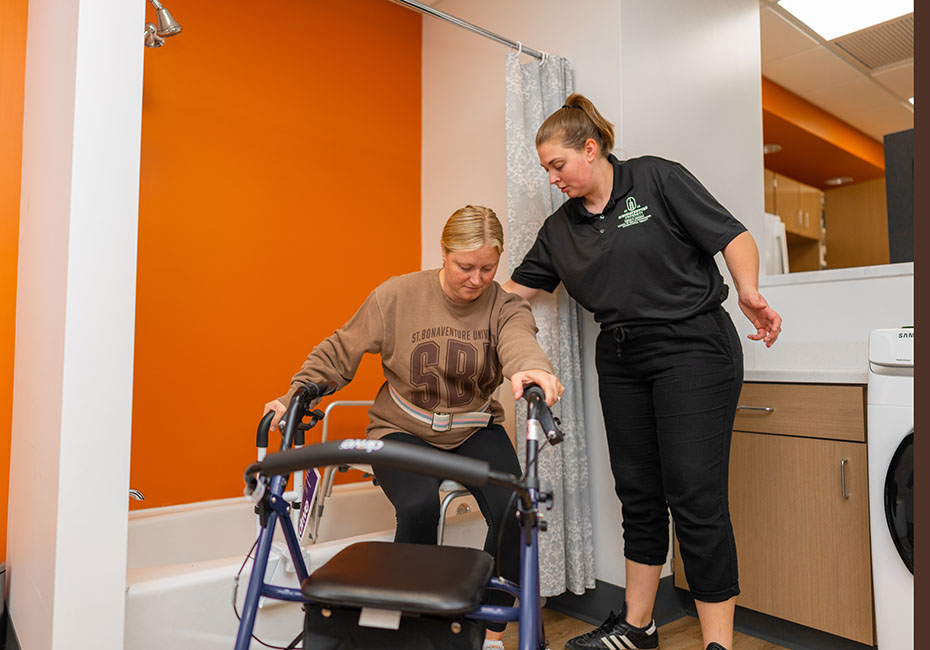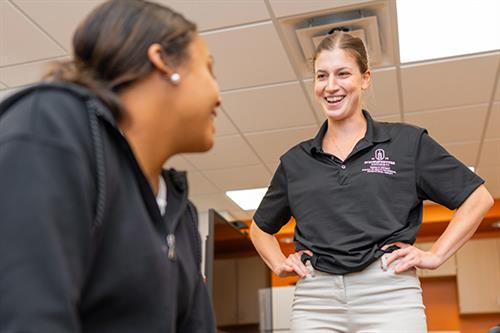The occupational therapy program at SBU educates students as generalist practitioners, in accordance with the requirements of the Accreditation Council for Occupational Therapy Education (ACOTE).
The Occupational Therapy Program at St. Bonaventure University is committed to the education of all qualified individuals, including people with disabilities who, with reasonable accommodation, are capable of performing the essential functions of the program.
Our program's policy is to comply with the Americans with Disabilities Act as Amended (ADAAA), Section 504 of the Civil Rights Act of 1973, and state and local requirements regarding students and applicants with disabilities. In accordance with federal regulations established by the ADAAA, the standards listed below are described to assist each candidate/student in evaluating his/her prospect for academic and clinical success.
When a student’s ability to perform these tasks is compromised, the student must demonstrate alternative means and/or abilities to perform the essential functions of the occupational therapy student practitioner described below.
Observation skills

- Students must be able to acquire a defined level of necessary information as presented through educational experiences relating to basic arts and sciences, as well as pre-professional, professional, and graduate occupational therapy courses.
- To achieve the required competencies in the classroom setting, students must perceive, assimilate, and integrate information from a variety of sources. These sources include lectures, printed materials, visual and auditory media, laboratory experiences, and hands-on demonstrations.
- Consequently, students must demonstrate adequate functional use of visual, tactile, auditory and other sensory and perceptual abilities, to enable such observations and information acquisition necessary for academic and clinical performance.
- Students must also be able to use observation skills. For example, students must be able to differentiate clients' occupational behavior in order to determine problems and needs, and to differentiate changes in anatomical structures, muscle quality and joint movements.
Intellectual/conceptual abilities
-
Students must demonstrate critical thinking skills so that they can problem-solve creatively, master abstract ideas, and synthesize information present in academic, laboratory and fieldwork settings.
- Students must be able to measure, calculate, reason, analyze, process, integrate, synthesize, apply and retain facts, concepts, and data related to the art and science of health care.
- Students must be able to apply theoretical knowledge and current research evidence to specific client populations and diagnoses, and justify the rationale for therapeutic interventions. Students must also recognize and apply pertinent legal and ethical standards.
Communication skills

Effective communication is critical for students to build relationships with faculty, advisers, fellow students, clients, clinical supervisors, other professionals, and caregivers, in their various roles of learner, peer, student practitioner, and university/program representative.
- Students must be able to gather, comprehend, utilize and disseminate information effectively, efficiently, and in accordance with professional standards and productivity expectations. Students are required to communicate in the English language both verbally and in writing, at a level consistent with competent professional practice.
- Students are expected to use grammar and vocabulary proficiently. They must be able to elicit information, gather information, and describe findings verbally and in writing (e.g., evaluation reports, treatment plans, progress notes, and discharge summaries), that are comprehensible by clients, care-givers, professionals and non-professionals.
- Students must be able to communicate accurately, sensitively and effectively with clients and professionals from different cultural and social backgrounds. They should be able to observe, recognize and understand non-verbal behavior. They must be able to establish rapport with clients and communicate evaluation and treatment information effectively, while adhering to principles of confidentiality.
Behavioral and social skills
- Students must demonstrate emotional stability and be capable of developing mature and effective interpersonal relationships with other students, faculty, clinical supervisors, and other professionals.
- Students must be able to tolerate physically and emotionally taxing workloads and to function effectively under stress. They must be able to adapt to changing environments, display flexibility and function in the face of real-world ambiguities.
- Students must exhibit the ability and commitment to work with individuals in fast-paced, demanding settings and to meet the needs of people from diverse cultures, age groups, and socioeconomic levels, without bias.
- Students must be prepared to work with individuals who are severely medically involved, injured or disabled, limited by cognitive, emotional and functional impairments, or exhibit extreme behavior that may elicit an aversive reaction.
The ability to successfully interact with such individuals without being judgmental or prejudicial is critical to establishing a therapeutic relationship and maintaining one’s professionalism (AOTA’s Code of Ethics).
Physical/motor skills & environmental requirements

- Students must possess fine motor and gross motor abilities sufficient to perform necessary therapeutic functions. For example, students must be able to use a tape measure, a goniometer, and a blood pressure cuff.
- Students must have sufficient stamina to sustain performance of assigned responsibilities, physical strength and coordination to effectively operate and maintain equipment (e.g. splint pan, heat gun, wheelchairs, paraffin, whirlpool, ultrasound), safely handle, transfer, and move clients, carry out medical procedures, perform evaluations, provide intervention with a variety of clients, and in multiple, non-isolated settings.
- Students must demonstrate good general fitness that includes but is not limited to the ability to walk, balance, bend, climb, stoop, kneel, crouch, rotate, coordinate arms, and reach overhead. Students are required to use multiple grasp and pinch patterns, including dexterity for writing and keyboard function, and firm grasp for sustained hand/arm use as in lifting, push/pull, twisting, transferring and carrying.
- Students must regularly lift and/or move objects up to 10 pounds, occasionally lift and/or move objects at 25-50 pounds, and infrequently lift/move objects at greater than 50 pounds.
- Students may be exposed to the following conditions: wet or humid internal environments; proximity to moving mechanical parts, fumes or airborne particles, hazardous materials, and blood borne pathogens; exposure to outdoor weather conditions, risk of electrical shock, objects of hot/cold temperature, or vibration.
Professional responsibility

- Students must exhibit the ability anticipate and successfully plan for unpredictable challenges within health/medical situations that require a high level of alertness and readiness for immediate and appropriate response without interference of personal or medical problems. This includes training for emergencies (e.g. CPR and infection control).
- Students must adhere to policies of the university, the program, and fieldwork sites. This may include, but is not limited to, professional dress and demeanor, conforming to the academic calendar, and meeting start dates for fieldwork assignments.
- Students are responsible for travel to and from classes and Level I and Level II fieldwork sites; attendance at classes and fieldwork assignments; and possession of organizational skills and stamina for meeting performance criteria within assigned time frames.
- Students must take the initiative to self-assess their own academic progress and direct their own learning. They must work cooperatively and collaboratively with other students on assigned projects, and participate willingly in a supervisory process involving external evaluation of their abilities and reasoning skills.